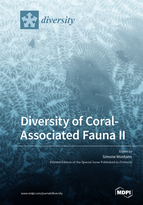Diversity of Coral-Associated Fauna II
A special issue of Diversity (ISSN 1424-2818). This special issue belongs to the section "Marine Diversity".
Deadline for manuscript submissions: closed (30 June 2022) | Viewed by 31465
Special Issue Editor
2. MaRHE Center (Marine Research and High Education Center), Magoodhoo Island, Faafu Atoll 12030, Maldives
Interests: coral diseases; coral reef ecology; coral restoration; biodiversity; symbiosis; hydrozoans taxonomy
Special Issues, Collections and Topics in MDPI journals
Special Issue Information
Dear Colleagues,
Coral reefs are one of the most diverse types of ecosystems on Earth and one of the richest in terms of species interactions. Mutualistic, commensalistic, and parasitic associations are extremely abundant in such ecosystems, and this is primarily due to the topographic complexity created by many benthic organisms, such as reef building corals, that provide a plethora of habitats to support an extraordinary diversity of organisms from all kingdoms of life. Scleractinian corals are usually the most likely to provide numerous different habitats and to support many symbiotic relationships. However, many other invertebrate groups, such as sponges, bryozoans, and other cnidarians, establish strict symbiotic relationships with other marine organisms. Despite a few studies that have shown that some associations may increase coral resistance to external disturbances, the nature of these relationships, as well as the factors that drive their establishment, are poorly investigated. Considering that the widespread degradation of coral reef ecosystems endangers the existence of intimate relationships that often go unrecognized, to improve our knowledge on the complex networks connecting the fates of reef species is of paramount importance to identify key vulnerabilities, to predict possible responses to species loss, and hence to address effective conservation actions.
This Special Issue aims to elucidate the hidden diversity of coral reefs, stimulating the description of new associations involving soft and hard corals, without excluding other benthic organisms, such as sponges, bryozoans, tunicates, and other cnidarians. For this reason, we welcome research on the diversity and ecology of coral-associated fauna, as well as studies documenting and evaluating practical monitoring techniques and conservation measures. Particular attention will be given to papers that use multidisciplinary approaches to study several aspects of coral-associated fauna.
Dr. Simone Montano
Guest Editor
Manuscript Submission Information
Manuscripts should be submitted online at www.mdpi.com by registering and logging in to this website. Once you are registered, click here to go to the submission form. Manuscripts can be submitted until the deadline. All submissions that pass pre-check are peer-reviewed. Accepted papers will be published continuously in the journal (as soon as accepted) and will be listed together on the special issue website. Research articles, review articles as well as short communications are invited. For planned papers, a title and short abstract (about 100 words) can be sent to the Editorial Office for announcement on this website.
Submitted manuscripts should not have been published previously, nor be under consideration for publication elsewhere (except conference proceedings papers). All manuscripts are thoroughly refereed through a single-blind peer-review process. A guide for authors and other relevant information for submission of manuscripts is available on the Instructions for Authors page. Diversity is an international peer-reviewed open access monthly journal published by MDPI.
Please visit the Instructions for Authors page before submitting a manuscript. The Article Processing Charge (APC) for publication in this open access journal is 2600 CHF (Swiss Francs). Submitted papers should be well formatted and use good English. Authors may use MDPI's English editing service prior to publication or during author revisions.
Keywords
- Biodiversity
- Climate change
- Threats and impacts
- Conservation
- Monitoring techniques
- Morpho-Molecular approach
- Cryptofauna
- Symbioses
- Ecological role






